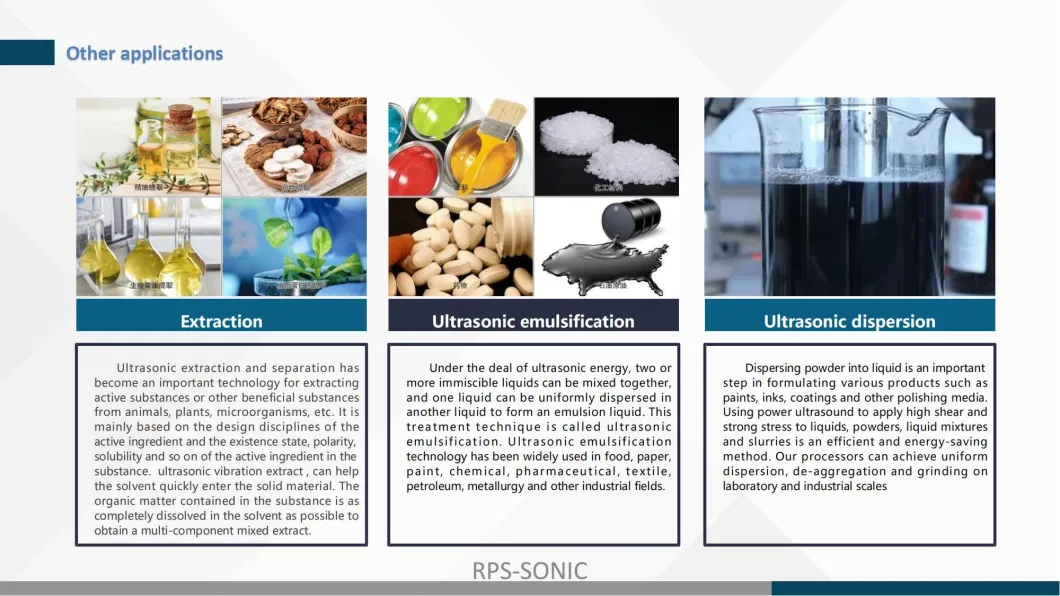

Highly Quality Ultrasonic Extraction Machine for Corn Oil Extract
Basic Info.
| Model NO. | SONO20-3000 |
| Operating Type | Continuous Type |
| Installation | None |
| Centrifuge Type | None |
| Distillation Equipment Type | Ultrasonic |
| Extraction Tower Type | Ultrasonic Extraction |
| Pressure | Medium Pressure |
| Condition | New |
| Voltage | 220/110V |
| Max Capacity | 10 L/Min |
| Intensity of Sound | 20 W/Cm² |
| Power | 1000W |
| Frequency | 20kHz |
| Transport Package | Wooden Case |
| Specification | 25KG |
| Trademark | RPS-sonic |
| Origin | China |
| HS Code | 8515900090 |
| Production Capacity | 200PCS/Month |
Packaging & Delivery
Package Size 110.00cm * 30.00cm * 30.00cm Package Gross Weight 26.000kgProduct Description
Highly Quality Ultrasonic Extraction machine for Corn Oil Extract| Model | SONO20-1000 | SONO20-2000 | SONO15-3000 | SONO20-3000 |
| Frequency | 20±0.5 KHz | 20±0.5 KHz | 15±0.5 KHz | 20±0.5 KHz |
| Power | 1000 W | 2000 W | 3000 W | 3000 W |
| Voltage | 220/110V | 220/110V | 220/110V | 220/110V |
| Temperature | 300 ºC | 300 ºC | 300 ºC | 300 ºC |
| Pressure | 35 MPa | 35 MPa | 35 MPa | 35 MPa |
| Intensity of sound | 20 W/cm² | 40 W/cm² | 60 W/cm² | 60 W/cm² |
| Max Capacity | 10 L/Min | 15 L/Min | 20 L/Min | 20 L/Min |

Ultrasonic extraction and separation based on the effective components in material and state of the existence of effective components, polarity, solubility and design a scientific and reasonable by using the method of ultrasonic vibration on the new technology of extraction, solvent quickly into the solid material, the material contained in the organic composition completely dissolved in solvent, as far as possible to get more ingredients extract, reoccupy appropriate separation methods, separate chemicals in the extract, then be refined, purified and chemical composition of the process to get the required monomer process.
Ultrasonic extraction is the use of ultrasonic radiation pressure produced by strong cavitation effect, the disturbance effect, high acceleration, breaking and mixing function of multistage effect, increase material molecular motion frequency and speed, increase the solvent penetration, increasing the target component into the solvent, promote extraction. Ultrasonic is a kind of elastic mechanical vibration wave, essentially different from the electromagnetic wave. Because electromagnetic waves can travel through a vacuum, and the ultrasonic transmission, must be in the medium to its through the media, form including expansion and compression, and that the movement of the fluid produced sharply, due to the change of sound pressure, solvent by compression and sparse, in acoustic sparse phase zone, air-pocket expansion grew up, and the surrounding liquid vapor or gas filled with. In the compression zone, air-pocket soon collapse, rupture, produce a large number of micro bubble, they can be used as a new gas nucleus. Now believe that the influence of ultrasound on chemical reactions, the main reason is that the micro bubble in grew up suddenly burst can produce strong shock waves.When sonicating liquids at high intensity, sound waves propagating into the liquid medium create alternating cycles of high pressure (compression) and low pressure (sparse), the rate of which depends on the frequency. During low-pressure cycling, high-intensity ultrasonic waves create small vacuum bubbles or voids in the liquid. When the bubbles reach a volume where they can no longer absorb energy, they collapse violently during high-pressure cycling, a phenomenon known as cavitation. During the explosion, very high temperatures (about 5,000K) and pressures (about 2,000 atm) will be reached locally. The collapse of the cavitation bubbles also leads to liquid jet velocities up to 280 m/s, and the resulting shear forces mechanically disrupt cell membranes and improve material transfer. Depending on the ultra
sound parameters used, ultrasound can have a destructive or constructive effect on cells, depending on the ultrasound parameters used.








